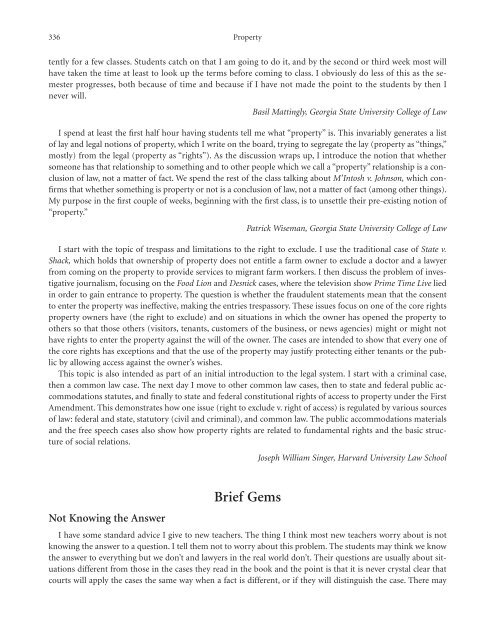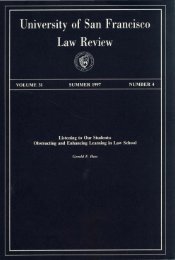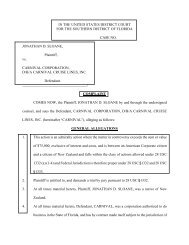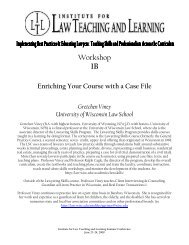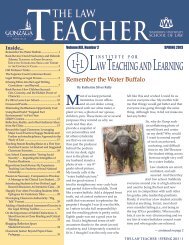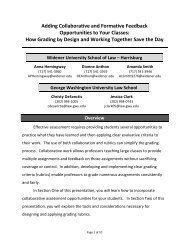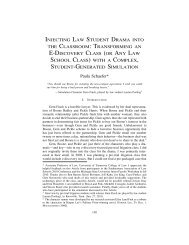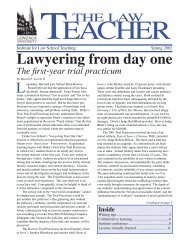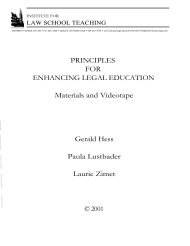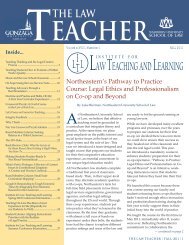Teaching the Law School Curriculum - Institute for Law Teaching ...
Teaching the Law School Curriculum - Institute for Law Teaching ...
Teaching the Law School Curriculum - Institute for Law Teaching ...
You also want an ePaper? Increase the reach of your titles
YUMPU automatically turns print PDFs into web optimized ePapers that Google loves.
336 Property<br />
tently <strong>for</strong> a few classes. Students catch on that I am going to do it, and by <strong>the</strong> second or third week most will<br />
have taken <strong>the</strong> time at least to look up <strong>the</strong> terms be<strong>for</strong>e coming to class. I obviously do less of this as <strong>the</strong> semester<br />
progresses, both because of time and because if I have not made <strong>the</strong> point to <strong>the</strong> students by <strong>the</strong>n I<br />
never will.<br />
Basil Mattingly, Georgia State University College of <strong>Law</strong><br />
I spend at least <strong>the</strong> first half hour having students tell me what “property” is. This invariably generates a list<br />
of lay and legal notions of property, which I write on <strong>the</strong> board, trying to segregate <strong>the</strong> lay (property as “things,”<br />
mostly) from <strong>the</strong> legal (property as “rights”). As <strong>the</strong> discussion wraps up, I introduce <strong>the</strong> notion that whe<strong>the</strong>r<br />
someone has that relationship to something and to o<strong>the</strong>r people which we call a “property” relationship is a conclusion<br />
of law, not a matter of fact. We spend <strong>the</strong> rest of <strong>the</strong> class talking about M’Intosh v. Johnson, which confirms<br />
that whe<strong>the</strong>r something is property or not is a conclusion of law, not a matter of fact (among o<strong>the</strong>r things).<br />
My purpose in <strong>the</strong> first couple of weeks, beginning with <strong>the</strong> first class, is to unsettle <strong>the</strong>ir pre-existing notion of<br />
“property.”<br />
Patrick Wiseman, Georgia State University College of <strong>Law</strong><br />
I start with <strong>the</strong> topic of trespass and limitations to <strong>the</strong> right to exclude. I use <strong>the</strong> traditional case of State v.<br />
Shack, which holds that ownership of property does not entitle a farm owner to exclude a doctor and a lawyer<br />
from coming on <strong>the</strong> property to provide services to migrant farm workers. I <strong>the</strong>n discuss <strong>the</strong> problem of investigative<br />
journalism, focusing on <strong>the</strong> Food Lion and Desnick cases, where <strong>the</strong> television show Prime Time Live lied<br />
in order to gain entrance to property. The question is whe<strong>the</strong>r <strong>the</strong> fraudulent statements mean that <strong>the</strong> consent<br />
to enter <strong>the</strong> property was ineffective, making <strong>the</strong> entries trespassory. These issues focus on one of <strong>the</strong> core rights<br />
property owners have (<strong>the</strong> right to exclude) and on situations in which <strong>the</strong> owner has opened <strong>the</strong> property to<br />
o<strong>the</strong>rs so that those o<strong>the</strong>rs (visitors, tenants, customers of <strong>the</strong> business, or news agencies) might or might not<br />
have rights to enter <strong>the</strong> property against <strong>the</strong> will of <strong>the</strong> owner. The cases are intended to show that every one of<br />
<strong>the</strong> core rights has exceptions and that <strong>the</strong> use of <strong>the</strong> property may justify protecting ei<strong>the</strong>r tenants or <strong>the</strong> public<br />
by allowing access against <strong>the</strong> owner’s wishes.<br />
This topic is also intended as part of an initial introduction to <strong>the</strong> legal system. I start with a criminal case,<br />
<strong>the</strong>n a common law case. The next day I move to o<strong>the</strong>r common law cases, <strong>the</strong>n to state and federal public accommodations<br />
statutes, and finally to state and federal constitutional rights of access to property under <strong>the</strong> First<br />
Amendment. This demonstrates how one issue (right to exclude v. right of access) is regulated by various sources<br />
of law: federal and state, statutory (civil and criminal), and common law. The public accommodations materials<br />
and <strong>the</strong> free speech cases also show how property rights are related to fundamental rights and <strong>the</strong> basic structure<br />
of social relations.<br />
Not Knowing <strong>the</strong> Answer<br />
Brief Gems<br />
Joseph William Singer, Harvard University <strong>Law</strong> <strong>School</strong><br />
I have some standard advice I give to new teachers. The thing I think most new teachers worry about is not<br />
knowing <strong>the</strong> answer to a question. I tell <strong>the</strong>m not to worry about this problem. The students may think we know<br />
<strong>the</strong> answer to everything but we don’t and lawyers in <strong>the</strong> real world don’t. Their questions are usually about situations<br />
different from those in <strong>the</strong> cases <strong>the</strong>y read in <strong>the</strong> book and <strong>the</strong> point is that it is never crystal clear that<br />
courts will apply <strong>the</strong> cases <strong>the</strong> same way when a fact is different, or if <strong>the</strong>y will distinguish <strong>the</strong> case. There may


